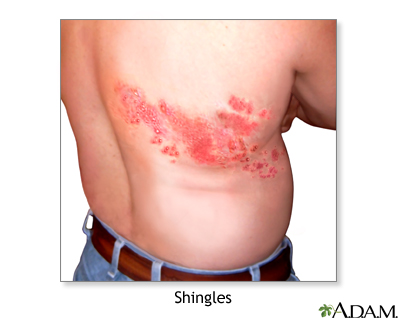Herpes Zoster (Shingles) is one of the most common skin conditions that I encounter in both my The Woodlands dermatology and Conroe dermatology offices. Shingles is a reactivation of the Varicella Zoster Virus (VZV), which causes chickenpox. After infection with chickenpox or vaccination with the chickenpox vaccine, the virus remains dormant in the dorsal root ganglion of the spinal cord. Later in life, VZV can reactivate and cause a rash localized to a dermatome. Dermatomes are areas of the skin innervated by a specific nerve. Initially, an urticarial phase of shingles occurs in which the skin becomes red and indurated just like in hives. Subsequently, small flaccid vesicles (blisters) emerge which can be very painful. Over a course of a week, these vesicles rupture and form a crust (scab) and ultimately can resolve with scarring. Up to 20 vesicles may appear outside the dermatome, but if more than 20 vesicles are outside the dermatome the shingles is considered “disseminated.” Disseminated Herpes Zoster occurs almost exclusively in immunosuppressed patients and the eruption can appear like chickenpox as vesicles are found over the entire body. Disseminated Herpes Zoster can be fatal as VZV can infect the lungs and central nervous system, so it requires hospitalization and IV antivirals such as Acyclovir. Pain is the hallmark symptom of shingles. In patients under 30, the pain may be non-existent as the intensity of pain is sometimes directly proportional to age. In a variation of shingles called Zoster sine herpete, there is pain in a dermatomal pattern but no zosteriform rash occurs. The thoracic (chest/back) dermatome is the most commonly affected area followed by the cranial (face) dermatome. The trigeminal nerve, which supplies the face, is the most common nerve involved. The incidence of shingles increases with age and is more common in white patients. It has been noticed that shingles is seen more commonly than in previous years, and some dermatologists postulate that the vaccination for chickenpox reduces the periodic “booster” of immunity that patients receive by being exposed to children with active chickenpox infection. Fortunately, the shingles vaccine has helped reduce the incidence of shingles. Patients with immunosuppression are at increased risk of developing shingles. Patients with shingles are infectious to immunosuppressed patients and anyone who has never had chickenpox or the chickenpox vaccine until the vesicles form a crust. Stress, both physical and emotional, can elicit shingles as well as an underlying malignancy or HIV infection. The most common complication of shingles is post herpetic neuralgia (see blog entry Viruses- Post Herpetic Neuralgia). Motor neuropathy (inability to move certain muscles) can also occur in 3% of cases and is three times more likely if the shingles is caused by an underlying malignancy. Most patients recover without any permanent motor deficits. If the sacral dermatomes are involved, a patient may have urinary retention or bowel obstruction. Ramsay Hunt syndrome occurs when a patient has shingles of the ear and the auditory and facial nerve become affected resulting in tinnitus (ear ringing), vertigo, deafness, and unilateral facial paralysis. Treatment is most effective when patients are initiated on antivirals early in the course of their shingles. Immunosuppressed patients required IV Acyclovir but most patients are treated with Valtrex 1g 3x/day or Famvir 500mg 3x/day for one week as well as Gabapentin 300mg 3x/day for one month to prevent post herpetic neuralgia. Elderly patients are encouraged to restrict their activity for a few days as this can lessen the chance of acquiring post herpetic neuralgia.
March 23, 2013




